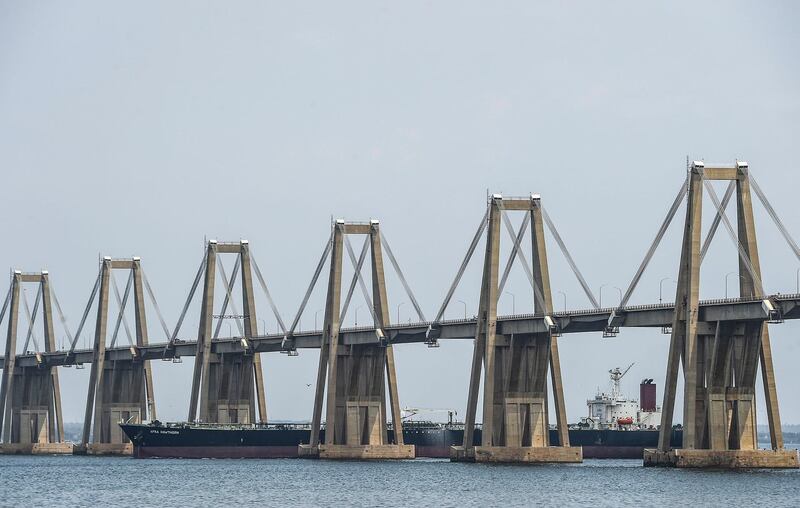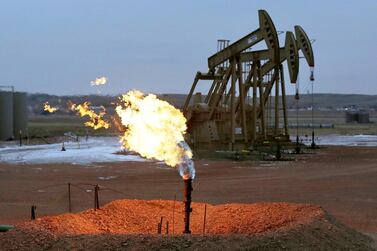The deal between Opec and some non-Opec states has been an impressive achievement. As the monitoring committee meets in Baku on Monday, they will find that compliance to production cuts has been high, excess stockpiles have fallen to normal levels and prices have recovered from a low of $28 per barrel in January 2016 to above $80 per barrel in November. But does the deal’s very success undermine it?
When the oil price began to drop in late 2014, guided by then Saudi oil minister Ali Al Nuaimi, Opec judged that it was time to fight a price war. Saudi Arabia jacked up production and intensified the slump, with the aim of diverting investment away from shale and other non-Opec basins. He had in mind the disastrous early 1980s, when the kingdom's attempts to shore up prices by cutting production without support from others led its exports to fall dramatically.
In 2016, the kingdom changed tack, Mr Al Nuaimi was replaced by Khalid Al Falih, and an alliance was forged with Russia, which in turn encouraged Iran and a group of non-Opec states, including Oman and others, to co-ordinate production cuts. This assuaged Saudi concerns that they would bear too much of the burden and lose market share to producers outside Opec. The road proved to be longer and harder than the Opec+ alliance had anticipated. However, by late last year inventories had been reduced to typical levels and prices had rebounded.
Nonetheless, other factors ran in the coalition’s favour too. The world economy, after some weakness in 2016, was stronger during 2017-18, and the after-effect of low prices boosted oil demand. After the Iran nuclear deal brought its production back during 2016, US President Donald Trump’s decision to reimpose sanctions took much of its oil off the market again starting in mid-2018. Venezuela’s output has been in free fall and in the next few months is only going to get worse.
Libya’s volatile production is, in its best months, bumping up against usable capacity. Nigeria is up with a new deepwater field but violence remains a threat in the Niger Delta. Algerian output has not been affected by the country’s widespread protests, but remains moribund. Iraq, which has given a fig leaf of adherence to the production cuts, and Kazakhstan, are the only significant producers who have chosen to challenge their assigned limits. And Alberta in non-Opec Canada has helped by volunteering an unexpected curb on its output.
In 2016, Opec’s market share of world petroleum was 38.7 per cent. If it sticks with the deal through this year, production remains at February’s levels, and Saudi Arabia and others make up for any further losses from Iran and Venezuela, that share will be down to 35.1 per cent by the fourth quarter. Meanwhile, Russia, another main beneficiary of the deal, has given up hardly any market share, while higher prices have supercharged shale drillers. That is the cost of boosting prices to current levels of around $67 per barrel, still considered barely adequate by many leading producers.
Of course, prices will be volatile and may spike at times because of upsets to production elsewhere. But Saudi Arabia and its allies will be encouraged to use their spare capacity to tame such spikes, particularly given the “NOPEC” bill making its way through US congress, threatening anti-trust litigation against the producers’ organisation.
The International Energy Agency’s latest forecast to 2024 expects growth in US shale to gradually level, but other non-Opec suppliers, notably Brazil and new entrant Guyana to step up. They project demand growth to gradually slide, even without factoring in a likely worldwide economic slowdown at some point.
Beyond 2024, the IEA’s outlook might appear more sanguine, as American shale growth is expected to slow and eventually reverse. Even assuming that happens, though, and shale oil development does not spread to other countries, oil demand will by then be facing increasing headwinds from electric vehicles and tougher action against climate change.
Overall demand for Opec crude is set to not increase at all to 2024, and perhaps not much beyond that. Its members will get some limited relief as an excess of light shale crude boosts relative prices for their typically medium and heavy grades. A likely jump in oil prices at the end of this year as new marine fuel regulations come in will be offset by lower demand.
Economic relief will be relative, favouring the stronger countries in the group, not exporters as a whole.
Within the overall cap, Iraq and the UAE should be able to increase production, taking market share from their less fortunate peers. Saudi Arabia, of course, could increase output but will not do so if it remains committed to market management. And Venezuela represents only downside for oil prices, since a new government would be able to engineer at least some recovery in its petroleum sector, with arguably legitimate president Juan Guaido promising openness to private investment.
Beyond successful market management, the producers’ organisation needs a vision, either an exit from, or a commitment to, indefinite restraint. Opec does not have an infinite runway.
Robin Mills is CEO of Qamar Energy, and author of The Myth of the Oil Crisis







